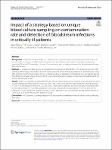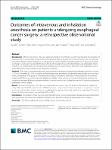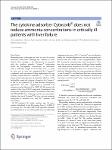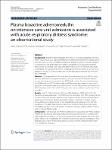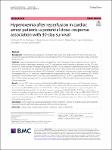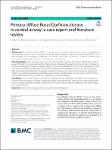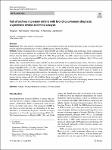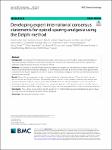Search
Author
- Daqing, Ma (3)
- Alexis, Ferré (2)
- Anna, Lybeck (2)
- Ashish K., Khanna (2)
- next >
Subject
- intensive care unit (8)
- acute respiratory dist... (5)
- chronic obstructive pu... (5)
- ICU (5)
- next >
Has File(s)
Search Results
Unique blood culture (UBC) has been proposed to limit the number of venipuncture and to decrease the risk of BC contaminations (BCC) without affecting their yield. We hypothesized that a multi-faceted program based on UBC in the ICU may reduce the rate of contaminants with a similar performance for bloodstream infections (BSI) identification. |
Different anesthetics may have opposite effects on the immune system, thus affecting the prognosis of tumor patients. Cell-mediated immunity forms the primary defense against the invasion of tumor cells, so manipulation of the immune system to produce an enhanced anti-tumor response could be utilized as an adjuvant oncological therapy. Sevoflurane has proinflammatory effects, while propofol, has anti-inflammatory and antioxidant effects. Therefore, we compared the overall survival (OS) and disease-free survival (DFS) of patients with esophageal cancer under total intravenous anesthesia and inhalation anesthesia. |
The lingual nerve is a branch of the mandibular nerve which is a branch of the trigeminal nerve and provides general sensation to the anterior two-thirds of the tongue, and this nerve lies deep to the hyoglossus muscle (Dotiwala and Samra 2018). |
Hemadsorption techniques are used in critical care for numerous indications, although the evidence is often limited. One example is the elimination of ammonia with the cytokine adsorber Cytosorb® (adsorption based on hydrophobic interactions of substances with a molecular weight of 5–55 kDa). Most recently, in vitro and in vivo data postulated that Cytosorb® (combined with continuous kidney replacement therapy (CKRT)) could eliminate ammonia [1, 2]. |
Divergence between deterioration to life-threatening COVID-19 or clinical improvement occurs for most within the first 14 days of symptoms. Life-threatening COVID-19 shares clinical similarities with Macrophage Activation Syndrome, which can be driven by elevated Free Interleukin-18 (IL-18) due to failure of negative-feedback release of IL-18 binding protein (IL-18bp). We, therefore, designed a prospective, longitudinal cohort study to examine IL-18 negative-feedback control in relation to COVID-19 severity and mortality from symptom day 15 onwards. |
Bioactive adrenomedullin (bio-ADM) is a vasoactive peptide with a key role in reducing vascular hyperpermeability and improving endothelial stability during infection, but it also has vasodilatory properties. Bioactive ADM has not been studied in conjunction with acute respiratory distress syndrome (ARDS), but it has recently been shown to correlate with outcomes after severe COVID-19. Therefore, this study investigated the association between circulating bio-ADM on intensive care unit (ICU) admission and ARDS. The secondary aim was the association between bio-ADM and ARDS mortality. |
Hyperoxemia may aggravate reperfusion brain injury after cardiac arrest. The aim of this study was to study the associations between different levels of hyperoxemia in the reperfusion period after cardiac arrest and 30-day survival. |
Rosai-Dorfman disease (RDD) is a rare benign non-langerhans cell histiocytosis, mainly involving lymph nodes and skin. It is even rarer occurring only in central airway of lung and in diffuse form. Central airway RDD is similar to malignant tumor in imaging by radiological method and in bronchoscopy features. It is difficult to differentiate it from primary airway malignant tumor and to diagnose correctively in time. |
This study aimed to systematically review and meta-analyze the available literature on the association between preterm infant bronchopulmonary dysplasia (BPD) and pre-adulthood asthma. |
The management of postoperative pain in anaesthesia is evolving with a deeper understanding of associating multiple modalities and analgesic medications. However, the motivations and barriers regarding the adoption of opioid-sparing analgesia are not well known. |

